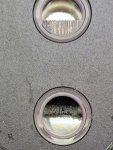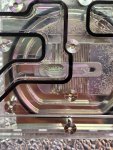Hello,
I purchased the Eisblock Aurora GPX-N GPU Waterblock for RTX 3090/3080 (Plexi with Backplate) in December. I installed into an existing system that had a CPU block, pump, reservoir and radiator. The system had been working fine for two years. All components are copper based (not aluminum).
A few days ago, the CPU and GPU temperatures started to rise and I noticed that the flow of water had slowed down considerably. After rebooting the computer, there was no flow at all. I inspected the pump and found that it works fine. After draining the system, I was able to determine that the input on the CPU block (the first point after the GPU) had completely clogged with debris (green spikes or crystals that clumped together). I was able to locate the origin of the green spikes/crystals to the middle of the GPU water block. To me it seems that the nickel plating, in the GPU block, is coming off and the copper is corroding and the plating is what clogged and destroyed the system. I can find chunks of this in the pump and in the radiator as well. The system is shot. I have had to switch to air cooling. I have attached a picture of the crystal clog in the GPU block as well as the CPU block showing the clogged input and clear output.
Can someone please get back to me to resolve this issue?
I purchased the Eisblock Aurora GPX-N GPU Waterblock for RTX 3090/3080 (Plexi with Backplate) in December. I installed into an existing system that had a CPU block, pump, reservoir and radiator. The system had been working fine for two years. All components are copper based (not aluminum).
A few days ago, the CPU and GPU temperatures started to rise and I noticed that the flow of water had slowed down considerably. After rebooting the computer, there was no flow at all. I inspected the pump and found that it works fine. After draining the system, I was able to determine that the input on the CPU block (the first point after the GPU) had completely clogged with debris (green spikes or crystals that clumped together). I was able to locate the origin of the green spikes/crystals to the middle of the GPU water block. To me it seems that the nickel plating, in the GPU block, is coming off and the copper is corroding and the plating is what clogged and destroyed the system. I can find chunks of this in the pump and in the radiator as well. The system is shot. I have had to switch to air cooling. I have attached a picture of the crystal clog in the GPU block as well as the CPU block showing the clogged input and clear output.
Can someone please get back to me to resolve this issue?





